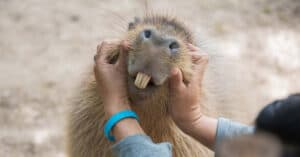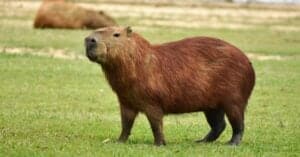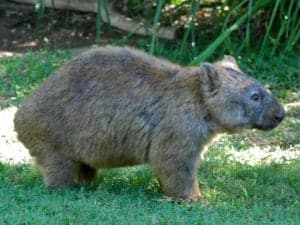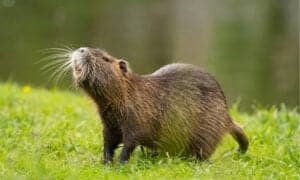What Do Capybaras Eat? Their Diet Explained
Capybaras are the largest rodent in the world. They can weigh up to 150 pounds and stand at about three feet tall, with a four-foot-long tail. Capybaras live in South America near rivers because they need water to keep their skin moist. If you see them on land, it means there has been a drought for months, and they’re desperately searching for water. With capybaras being such large rodents, you might be wondering, just what do capybaras eat to get so big? Let’s dive into the diets of these massive animals!
What Do Capybaras Eat?

sunsinger/Shutterstock.com
Capybaras eat a mix of aquatic vegetation, grasses, and plant roots. They need to eat a lot because they have a limited ability to store fat in their bodies. In fact, capybaras can’t go for long periods of time without food and can undergo periods of starvation if they don’t find enough food to eat on a consistent basis. The capybara has a four-chamber stomach that allows them to digest tough plant materials that humans can’t digest easily. In addition, this multi-chambered stomach is extremely efficient at pulling out nutrients from plans.
A study from research journal Mammalia found that 70% of a capybara’s diet comes from just four plants: sedges (Cyperaceae), switchgrass (Panicum grumosum), Bermuda grass (Cynodon), and crowngrass (Paspalum).
The foods that Capybaras eat include:
- Aquatic plants
- Sedges
- Grasses
- Crowngrass
- Switchgrass
- Bermuda grass
- Hay
- Bark
- Plant roots
- Reeds
How Much Food Does a Capybara Eat?
A capybara eats between 3% to 4% of its body weight every day, which is approximately six to eight pounds. One interesting fact about capybaras is they will eat their own poop. While this might sound distasteful to a human, its actually quite beneficial to capybaras! Their feces are rich in protein. While capybaras have a specialized stomach to digest many of the grasses they eat, there’s still plenty of nutrients to be absorbed by eating their feces and giving the prior day’s meal a a second digestion!
What do different types of Capybaras eat?

There are two different types of Capybaras. The lesser capybara is found in Colombia and Venezuela and as its name implies, it is smaller than greater capybara whose range extends across the Amazon and into Argentina. As the two capybaras live in different locations, the specific plan life they eat depends on what’s locally available. However, both their diets are similar in that they feed on aquatic plants and grasses.
How Does The Diet of a Capybara Impact Other Species?
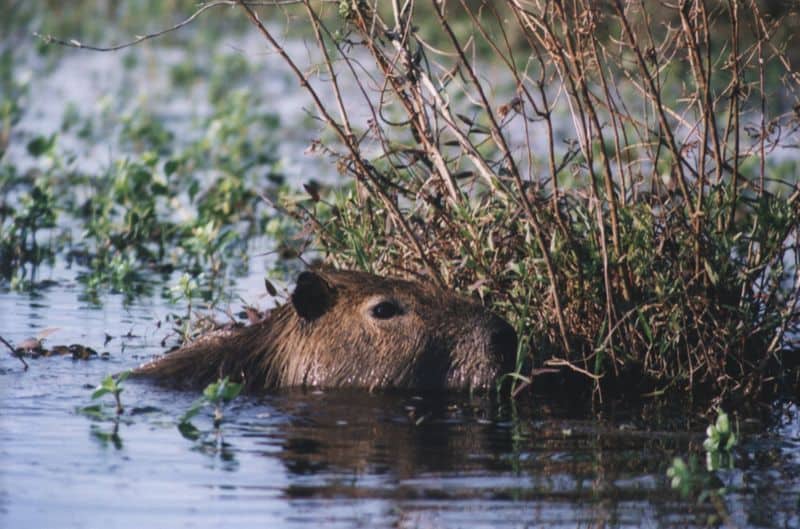
Capybaras feed on a number of plants that could begin to overwhelm river and lake ecosystems without a herbivore to keep their growth in check. Sections of the capybara’s range – such as the Pantanal in Brazil – experience more severe dry seasons where capybaras will adjust their diets away from grasses and toward reeds. Capybaras are also prey to species like jaguars, caiman, and ocelots. Their large size provides a valuable meal for South America’s largest predators.
Are Capybaras dangerous to humans?
Capybaras are not considered to be dangerous to humans. They are timid animals and will usually hide from humans if they see them. However, if they are cornered or feel that their young are in danger, like most animals they will try to defend themselves. With large teeth their bites have sent people to the hospital in the past.
More from A-Z Animals
Capybaras are the largest rodent in the world. They can weigh up to 150 pounds and stand at about three feet tall, with a four-foot-long tail. Capybaras live in South America near rivers because they need water to keep their skin moist. If you see them on land, it means there has been a drought for months, and they’re desperately searching for water. With capybaras being such large rodents, you might be wondering, just what do capybaras eat to get so big? Let’s dive into the diets of these massive animals!
What Do Capybaras Eat?

sunsinger/Shutterstock.com
Capybaras eat a mix of aquatic vegetation, grasses, and plant roots. They need to eat a lot because they have a limited ability to store fat in their bodies. In fact, capybaras can’t go for long periods of time without food and can undergo periods of starvation if they don’t find enough food to eat on a consistent basis. The capybara has a four-chamber stomach that allows them to digest tough plant materials that humans can’t digest easily. In addition, this multi-chambered stomach is extremely efficient at pulling out nutrients from plans.
A study from research journal Mammalia found that 70% of a capybara’s diet comes from just four plants: sedges (Cyperaceae), switchgrass (Panicum grumosum), Bermuda grass (Cynodon), and crowngrass (Paspalum).
The foods that Capybaras eat include:
- Aquatic plants
- Sedges
- Grasses
- Crowngrass
- Switchgrass
- Bermuda grass
- Hay
- Bark
- Plant roots
- Reeds
How Much Food Does a Capybara Eat?
A capybara eats between 3% to 4% of its body weight every day, which is approximately six to eight pounds. One interesting fact about capybaras is they will eat their own poop. While this might sound distasteful to a human, its actually quite beneficial to capybaras! Their feces are rich in protein. While capybaras have a specialized stomach to digest many of the grasses they eat, there’s still plenty of nutrients to be absorbed by eating their feces and giving the prior day’s meal a a second digestion!
What do different types of Capybaras eat?

There are two different types of Capybaras. The lesser capybara is found in Colombia and Venezuela and as its name implies, it is smaller than greater capybara whose range extends across the Amazon and into Argentina. As the two capybaras live in different locations, the specific plan life they eat depends on what’s locally available. However, both their diets are similar in that they feed on aquatic plants and grasses.
How Does The Diet of a Capybara Impact Other Species?

Capybaras feed on a number of plants that could begin to overwhelm river and lake ecosystems without a herbivore to keep their growth in check. Sections of the capybara’s range – such as the Pantanal in Brazil – experience more severe dry seasons where capybaras will adjust their diets away from grasses and toward reeds. Capybaras are also prey to species like jaguars, caiman, and ocelots. Their large size provides a valuable meal for South America’s largest predators.
Are Capybaras dangerous to humans?
Capybaras are not considered to be dangerous to humans. They are timid animals and will usually hide from humans if they see them. However, if they are cornered or feel that their young are in danger, like most animals they will try to defend themselves. With large teeth their bites have sent people to the hospital in the past.

